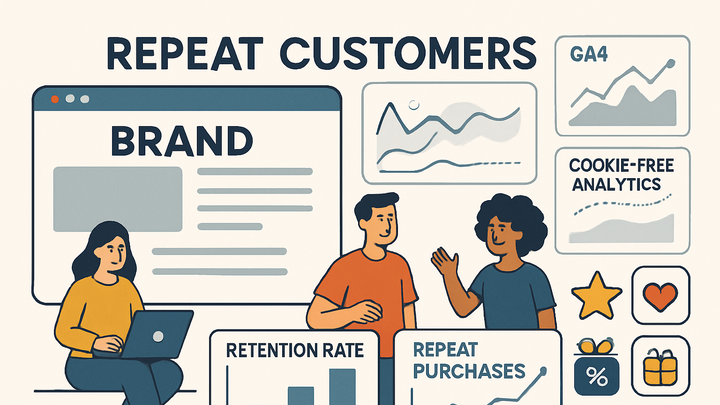Published on 2025-06-26T05:00:16Z
What is Customer Loyalty? Examples for Customer Loyalty in Analytics
Customer Loyalty in analytics measures how committed customers are to continue purchasing and engaging with a brand. It reflects the degree to which customers prefer and repeatedly choose your products or services over competitors. High customer loyalty often correlates with increased revenue, word-of-mouth referrals, and long-term business growth. Analytics platforms like Google Analytics 4 (GA4) and cookie-free tools such as PlainSignal help track loyalty by monitoring metrics including repeat purchase rate, retention rate, and loyalty program participation. Understanding and enhancing customer loyalty enables businesses to tailor marketing efforts, improve customer experiences, and build sustainable relationships.
Customer loyalty
Customer Loyalty gauges repeat purchase likelihood and brand advocacy, tracked via metrics like retention, repeat purchase rate, and loyalty program engagement.
Importance of Customer Loyalty
Building customer loyalty is crucial because loyal customers:
- Spend more over time and generate higher lifetime value.
- Become brand advocates, referring friends and amplifying your marketing.
- Provide valuable feedback to improve products and services.
Measuring loyalty helps prioritize initiatives that foster long-term relationships rather than one-off transactions.
-
Revenue growth
Loyal customers tend to make repeat purchases, increasing average order value and lifetime value without proportional acquisition costs.
-
Brand advocacy
Satisfied, loyal customers recommend your brand to others, driving organic growth and reducing reliance on paid advertising.
Measuring Customer Loyalty in Analytics
Analytics platforms offer specialized reports and metrics to quantify loyalty. GA4 provides cohort and retention analysis, while PlainSignal delivers cookie-free insights into repeat behavior.
-
Repeat purchase rate
The percentage of customers who return to make another purchase within a defined period.
-
GA4 setup
Use the purchase event and Client ID or User ID to calculate the proportion of users with multiple purchases.
-
PlainSignal setup
Track purchase events without cookies; define a segment for users with more than one purchase event.
-
-
Retention rate
The percentage of customers who engage or purchase again after their first interaction over time.
-
GA4 cohort reports
Navigate to Life cycle → Cohort analysis to view retention curves by acquisition date.
-
PlainSignal cohorts
Create cohorts in the dashboard based on first-visit date and subsequent engagement events.
-
Implementing Tracking Code
Accurate loyalty metrics depend on proper event tracking. Embed your analytics scripts and configure user identifiers and purchase events.
-
GA4 tracking code
Standard GA4 gtag.js snippet capturing pageviews, user_id, and custom purchase events.
-
User id
Set the
user_idparameter to unify sessions across devices for accurate repeat purchase calculation. -
Purchase event
Send
purchaseevents with relevant product and transaction details to analyze repeat behavior.
-
-
PlainSignal tracking code
Cookie-free analytics script to capture pageviews and custom events for loyalty metrics.
-
Integration snippet
<link rel="preconnect" href="//eu.plainsignal.com/" crossorigin /> <script defer data-do="yourwebsitedomain.com" data-id="0GQV1xmtzQQ" data-api="//eu.plainsignal.com" src="//cdn.plainsignal.com/plainsignal-min.js"></script> -
Configuration
Replace
data-idwith your PlainSignal site ID and setdata-doto your domain for accurate attribution.
-
Best Practices for Enhancing Loyalty
Use analytics insights to implement strategies that foster stronger customer bonds and repeat engagement.
-
Personalized offers
Leverage behavior and purchase history to deliver targeted promotions that resonate with individual customers.
-
Loyalty programs
Design points-based or tiered reward systems and track participation rates to optimize program structure.
